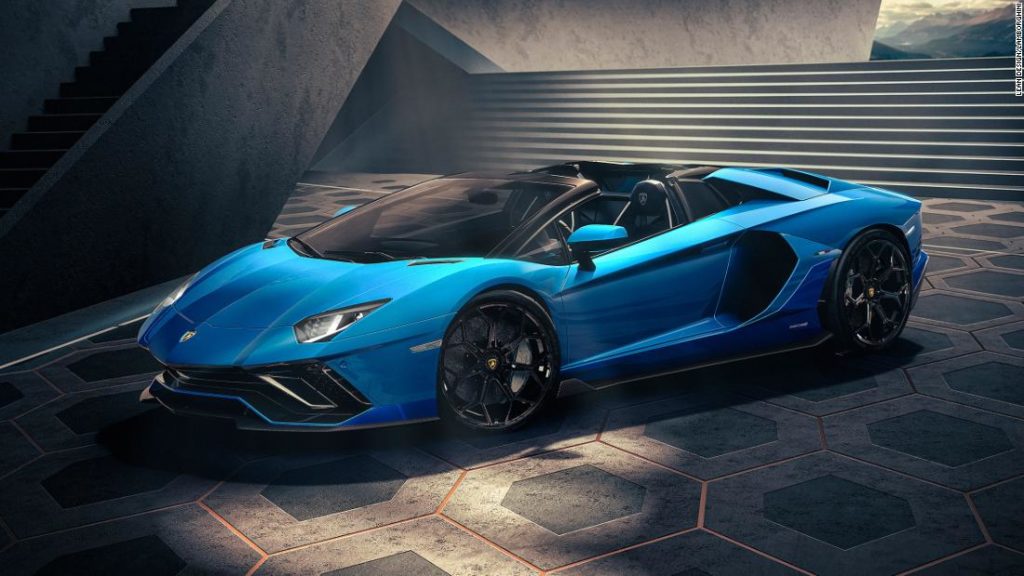The new Lamborghini Aventador LP 780-4 Ultimae is the latest of a series of 12-cylinder Lamborghini supercars stretching all the way back to the 1966 Miura, which is generally regarded as the first modern supercar. That was followed by the Countach, which became the prototypical Lamborghini supercar. Its wedge-shaped body has been copied by every Lamborghini sports car since, including the company’s flagship Aventador.
The Aventador LP 780-4 Ultimae combines the general exterior styling of the Aventador S with the mechanical engineering of the more extreme Aventador SVJ. This new model has more power than either one, though. The Ultimae’s V12 engine produces up to 769 horsepower, 10 more than the SVJ and 39 more than Aventador S.
Like other current Aventador models, the all-wheel-drive Ultimae has four-wheel steering, which allows it to turn tighter corners and make smoother lane changes in highway driving. The front bumper has been redesigned to provide more aerodynamic downforce on the car’s front wheels for better handling. Only 350 coupe and 250 convertible versions of the Ultimae will be built. Prices for the coupe version will start at about $500,000 and for the convertible at just under $550,000.
Lamborghini’s other sports car model, the V10-powered Huracán, will continue as a gasoline-only model until 2024, Lamborghini chief executive Stephan Winkelmann said.
Lamborghini will later offer a fully electric four-seat car and, after that, Lamborghini’s replacement for the Urus SUV will also be fully electric, he said. The company has not said when it might offer a fully electric two-seat sports cars.
Lotus’ fully electric future
When Lotus’s last gasoline-powered model, the Emira, enters production next spring it will be powered by the same Toyota V6 engine that has been used in other Lotus cars, like the Exige and Evora.
A few months later it will also be produced with a turbocharged 4-cylinder engine made by AMG, the performance division of Mercedes-Benz. The AMG engine, the first to be used in a Lotus car, will be offered with a new twin-clutch automatic transmission similar to ones used in racing cars. Twin-clutch transmissions can provide faster shifts and a more direct-feeing connection between the engine and the wheels than an ordinary automatic transmission.
The engines will produce between 360- and 400-horsepower, but Lotus would not specify which engine is more powerful. Besides the Toyota engine, and the manual and automatic transmissions that will go with it, the Emira is, otherwise, an all-new car, said Matt Windle, managing director of Lotus Cars. Prices for the Emira will start at £60,000 in Britain, including taxes, an amount equivalent to about $82,000.
Windle acknowledged that making electric sports cars is a challenge because of conflicting customer requirements for both driving range and high performance.
“The thing with sports cars is people want them to go a long way, but they also want them to go very fast, very quickly,” he said.
Windle had previously left Lotus to work with Tesla to develop the Tesla Roadster, which was based on a Lotus chassis. He rejoined the British automaker in 2017.
He’s confident that people will enjoy the performance electric cars can offer once they feel the instant response from electric motors.
“Nobody ever said, ‘If it only had an exhaust,” he said.
You may also like
-
Afghanistan: Civilian casualties hit record high amid US withdrawal, UN says
-
How Taiwan is trying to defend against a cyber ‘World War III’
-
Pandemic travel news this week: Quarantine escapes and airplane disguises
-
Why would anyone trust Brexit Britain again?
-
Black fungus: A second crisis is killing survivors of India’s worst Covid wave

